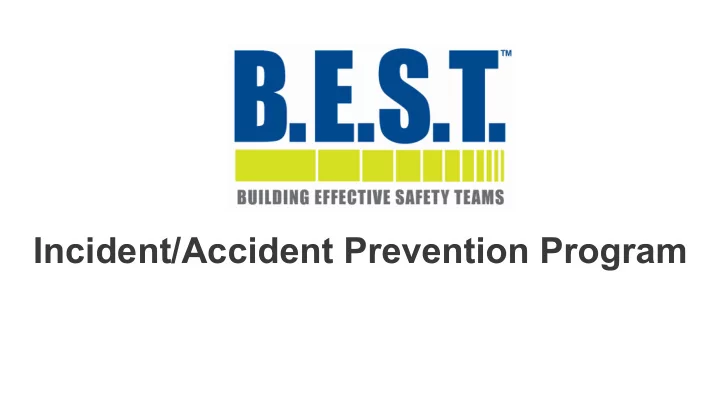

Incident/Accident Prevention Program
Training Objectives: At the end of the session, team members should be familiar with: Ø Building Effective Safety Ø Incident Prevention Teams Ø Accident Report Policy Ø Fit for Duty Ø Incident Scenarios Ø Drug Free Workplace Ø Property Damage Reports
B.E.S.T.™ P.A.C.E.™: Proactive Accountable Collaborative Effective At the end of the session, team members should be familiar with: • Building Effective Safety Teams Incident Prevention • Fit for Duty Accident Report Policy • Drug Free Workplace Incident Scenarios Property Damage Reports
Atalian ’ s B.E.S.T.™ Safety is a core value in all that we do, every day • We have a shared responsibility to resolve unsafe conditions • Stop at-risk behaviors; report/resolve unsafe conditions • Maintain a safe work environment for all team members, customers, and public
B.E.S.T.™ Building Effective Safety Teams™ Ø Teams take ownership of continuous improvement of safety processes, reviewing near miss and incident investigations, audits, and review company performance. Ø Teams are accountable and take ownership for the safety culture. Ø Teams identify hazards, while proactively working to improve safety. This creates the foundation for a World Class Safety Standard!
Atalian ’ s B.E.S.T.™ • With changes in attitudes and behaviors in the workplace it has been found to make major improvement through proactive steps in the losses experienced by workplaces due to accidents and illnesses by completing: Ø Investigation of Near miss incidents Ø 5-Whys Root Cause Analysis Ø Re-education as part of our process to reduce and eliminate incidents B.E.S.T.™ and P.A.C.E. develops a proactive safety culture!
Fit for Duty
Fit for Duty Situations that come up that require a deeper look by QHSE and coordination with Human Resources: Ø Based upon understanding of the team member's job description, can the team member perform the essential functions of his/ her job (including ability to work safely in the work environment?) Ø Does the team member present characteristics that are associated with increased risk of harm to self or others? Ø Any injury/ illness that prevents team member from being able to work in client environments Ø ADA (Americans with Disabilities Act) potential situations.
Fit for Duty When to test All incidents require post incident testing with lab for verification. Any occupational health or hospital testing requires notification to the QHSE team. Ø Post-Offer, Pre-Employment Drug Testing Ø Reasonable Suspicion Testing Ø Post-Accident Injury Testing Ø Property Damage Ø Follow up testing after Return-to-Duty from Assessment or Treatment
Fit for Duty Follow up drug test
• Consult your Branch Manager, QHSE department, and Human Resources before the assessment is performed. • The completed report should be sent to the QHSE and HR Departments whenever a team member is tested for reasonable cause.
Drug Free Workplace
Drug Free Workplace Policy Our policy states: Ø It is a violation of company policy for any employee to possess, sell, trade, or offer for sale illegal drugs or otherwise engage in the illegal use of drugs or alcohol on the job. Ø It is a violation of company policy for anyone to report to work under the influence of illegal drugs or alcohol - that is with illegal drugs or alcohol in his or her body. Ø It is a violation of the company policy for anyone to use prescription drugs illegally. Ø Violations of this policy are subject to disciplinary action up to and including termination.
Incident Prevention 1. Define the Root Cause 2. Analyze 3. Identify Possible Solutions 4. Implement Decisions 5. Review Results
Cost of Incidents
Incident Prevention Direct vs Indirect Costs
Employer Modifier Rate (EMR) EMR regulates your premium rate and incident history and has a longevity of 3 years used by the insurance industry to determine past/projected premiums. Quick Summary Less than 1.00 is the target rate Any rate over 1.01 is Penalty Rated Annual Premium - $500,000.00 EMR= 1.00 Premium= $500,000.00 EMR= 1.50 Premium= $750,000.00 EMR= 0.75 Premium= $375,000.00 Savings of $375,000.00 on your insurance premium from the difference of 1.50 to 0.75
Medcor Process We Must Call Medcor 1-800-775-5866 The Medcor Report serves as the First Report of Incident.
Medcor Usage When do we call Medcor? Ø Burns Ø Superficial foreign body in eye Ø Chemical Reactions Ø Blisters Ø Superficial lacerations Ø Slips, Trips, & Falls Ø Strains Ø Contusions Ø Superficial injury/abrasion Ø Insect stings
Medcor Usage Non-Injury/Work Related Incidents At The Worksite • When a team member has a condition requiring a 911 call , we still contact Medcor to log the incident as a record that the team member was removed from the site and transported to the hospital. • Examples would be life threating such as chest pains, stroke symptoms, when the employee requests transport, anything not related to an action that involved work, our chemicals, etc. • QHSE will have the incident properly classified once the health and safety of the team member has been determined. Manager-You Must Call Medcor.
Medcor Notice • Post the Medcor Notice in the designated team area. • Add Medcor to the Badges. • Review during Site-Specific Orientation.
Recommend
More recommend